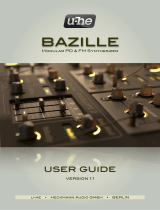
- Quick Start Guide -
BASIC AMPLIFIER CONNECTION SETUP
1. Using an unbalanced instrument cable, plug the output of your instrument into
the INST Input Jack on the right side of the Ring Thing.
2. Connect an unbalanced instrument cable from the MONO L output jack on the
left side of the Ring Thing. Connect the other end of the instrument cable to the
input of a guitar, bass, or keyboard amplifier.
3. Plug the AC Adapter into a wall outlet.
4. Plug the barrel connector of the AC Adapter into the 9V power jack at the top of
the Ring Thing.
Polarity is center negative
.
5. Apply power to the amplifier.
BASIC SETTINGS FOR RING MODULATOR MODE
–
This mode brings back all the
sounds of the Frequency Analyzer, with a few extras.
1. Connect the Ring Thing as described in Basic Amplifier Connection Setup.
2. Press the BYPASS footswitch so the STATUS LED is on
3. Press the MODE knob so that the Left LED is lit: RM.
4. Turn the following knobs to 50% or 12 o’clock: BLEND, WAVE, FINE/DEPTH, and
COARSE.
5. Turn the FILTER/RATE knob fully clockwise.
6. If an expression pedal is plugged in set it to the toe down position.
7. To change the modulation frequency, turn the FINE and/or COARSE knobs.
Automatically Tune the Ring Modulator –
Play a single note on your
instrument and then press and hold the PRESET/TUNE footswitch for 1 second. The
Ring Thing will automatically tune its internal modulator to the note you are playing.
This function is monophonic, it is designed to search for the fundamental pitch rather
than figure out what chord is being played. The PRESET/TUNE footswitch can be held
down to continuously tune the ring modulator to the input signal.
The WAVE Function –
the WAVE knob sets the waveform of the Ring Modulator
in RM and PS modes. Starting from full counter-clockwise, the choices are: SQUARE,
SINE, RAMP DOWN, RAMP UP, and TRIANGLE. Try turning the knob as you play, you
will notice some waveforms produce more harmonics than others. Additionally you
can crossfade from SQUARE to SINE to RAMP DOWN, then it switches to RAMP UP
and TRIANGLE.
Using an External Oscillator -
To use an external oscillator, as the RM’s carrier,
plug the output of another instrument, recording or mic pre into the MOD input jack
and turn the WAVE knob fully counter-clockwise. The signal at the MOD input jack
will override the Ring Thing’s internal modulator. In RM, UB and LB modes, the
















